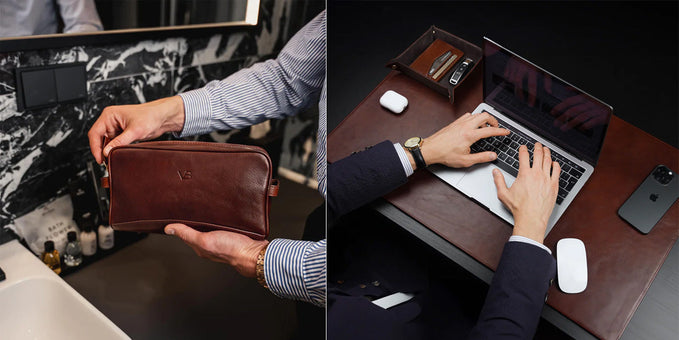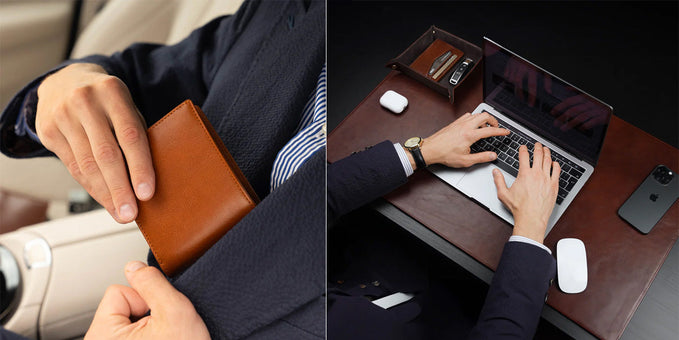Buffalo leather

Are you wondering what the difference between cow and buffalo leather is?
First you may need to better understand the term “buffalo”, as the Asian Water Buffalo and African Cape Buffalo are the only animals who are officially regarded as buffalos, even though the North American bison are often called buffalo too.
This means it’s important to know what you are asking for when you are seeking out buffalo leather.
If you’re not quite sure what you need, you could end up with a garment made from an Asian Water Buffalo when you actually want to purchase North American bison leather.
What exactly is buffalo leather?

Buffalo leather, derived from domestic buffalo hides, offers remarkable strength and flexibility.
- Three types of buffalo, namely American Buffalo, African Cape Buffalo, and Asian Water Buffalo, provide suitable hides for buffalo leather.
- Asian Water Buffalo, accounting for 97% of the world's buffalo population, is a primary source for water buffalo leather.
- American Buffalo hide, also known as bison, differs from other buffalo hides with its less porous nature and shallower texture.
- The pronounced grain of buffalo leather, available in various colors and finishes, boasts deep tones that lend it an impressive texture.
- Through the tanning process, buffalo leather gains versatility, enabling its use in furniture, shoes, belts, and bags within the fashion industry.
What types of buffalo leather are there?
Various materials come under the category of buffalo leather. Find out more about some of the most popular by reading on.
Full-grain leather
Full-grain buffalo leather is renowned for its outstanding quality. It is manufactured from the top layer of domestic American buffalo hide.
The top layer offers various fantastic characteristics associated with buffalo hides. This is what provides full-grain buffalo leather with its unique, naturally beautiful appearance.
Full-grain buffalo leather is renowned for its durability. It also has a highly appealing texture and has been used to make wallets, boots, and various other tough products. It’s also very easy to clean and comes with tough fibers that help you avoid penetration from lint, dust and animal hair.
Cleaning it with a soap cloth to maintain a smooth finish is easy. The material has a high resistance to dirt. It develops a rich patina that gets twice as thick with time when it is conditioned annually.
Top-grain buffalo leather

This second-best quality top-grain leather is manufactured from the top layer of domestic American buffalo hide.
Top-grain leather is mainly sanded down in order to remove any imperfections which could be present. Top-grain also has natural cowhide characteristics which provide it with a unique appearance, great durability, and impressive thickness.
Genuine buffalo leather
This is the lowest quality buffalo leather available.
It is thinner and weaker than the leather grains we have already discussed. Although this option is of lower quality, the term “genuine” is still used to market it and make it more appealing.
Nonetheless, it has less dirt resistance, and weak fiber and is widely regarded as low-quality split leather.
Pull-up buffalo leather
This high-quality buffalo leather is mainly coated with an aniline dye.
This gives the leather a richer appearance and makes it appear more impressive in terms of color.
This buffalo leather can be treated with a fusion of oils and transparent waxes to improve the texture and the finish. In pull-up buffalo leather, the hides’ blemishes tend to be kept intact.
Water buffalo leather
Water buffalo leather originates from the hides of the Asian water buffalo.
It's important to note that there are three types of buffalo: the Asian water buffalo, the American or Bison buffalo, and the African Cape buffalo.
Notably breathable and thicker than other leather varieties, water buffalo leather offers remarkable flexibility, allowing manufacturers to craft a diverse range of stylish luxury products suitable for daily use.
How is buffalo leather manufactured?

Buffalo leather manufacturing involves a multi-step process. First, the hide is salted and dried for preservation, which takes about three to five days. Next, the hides are taken to a tannery for cleaning and preparation.
They undergo thorough cleaning, including removal of dirt and dust, through soaking in water and disinfectants. Hair is then removed, and the hides are thinned and made ready for further treatment.
De-lining and pickling follow to ensure proper pH levels for quality and strength. Buffalo leather often undergoes vegetable tanning for the desired appearance and finish. This process prioritizes natural techniques, minimizing the use of chemicals and toxins.
Related leather guides:
- Leather
- Faux leather
- Vegan leather
- Bonded leather
- Genuine leather
- Pleather
- Top grain leather
- Vegetable tanned leather
- What is artificial leather?
- What is full grain leather
- Mushroom leather
- Napa leather
- Pebbled leather
What does buffalo leather look like?
Buffalo leather boasts a distinctive grain that surpasses that of bovine leather. With a variety of colors and finishes to choose from, it is highly esteemed for its deep, rich tones.
How does buffalo leather age?
With proper care, buffalo leather can endure a lifetime. Over time, it develops a captivating patina, enhancing its inherent beauty.
How tough is buffalo leather?
Renowned for its toughness, buffalo leather boasts an epidermal layer up to three times thicker than cowhide. Unlike cowhide, buffalo hides are not stretched during tanning, resulting in greater thickness and tear resistance.
Full-grain buffalo leather stands as one of the strongest options on the market.
Is buffalo leather good quality?
Buffalo leather is favored for its perfect balance of softness, flexibility, strength, and durability.
Full-grain buffalo leather is esteemed for its remarkable aesthetic appeal and ability to withstand a lifetime of use, solidifying its status as top-quality leather.
Related articles on leather:
- Leather grades
- How is leather made
- Where does leather come from
- Leather guide for beginners
- What is leather patina
- Leather tanning
- Is leather waterproof?
- Buying a leather bag
What exactly is ‘Genuine buffalo leather’?
While numerous products claim to be crafted from 'genuine buffalo leather,' skeptics argue that this label is often employed to enhance the perceived quality of subpar leather.
For an authentic and uncompromising leather experience, full-grain leather reigns supreme, retaining the hide's natural markings and imperfections.
In contrast, top-grain leather has flaws removed, resulting in a more uniform appearance but potentially sacrificing strength compared to full grain.
Positioned as the third layer, 'genuine leather' is the thinnest and weakest, often stamped and dyed to imitate top-grain leather.
Related articles:
- Suede
- PU leather
- Bonded leather vs Faux leather
- Italian leather
- How to tell if leather is real
- Suede vs Leather
- What is Real Leather
- Pu Leather vs Faux Leather
- Alternative Leather
- Chrome Tan Leather
Conclusion
We hope you enjoyed our article on buffalo leather.
If you have any questions or comments, contact us at info@vonbaer.com, or leave them in the comments.
Want to read more? Check out our Leather pages here.

Author: Albert Varkki
Albert Varkki is the co-founder of Von Baer. He understands leather products as a consumer, supplier, and a manufacturer, helping you with the inside knowledge you need, to choose the perfect leather product for you.
We strive for the highest editorial standards, and to only publish accurate information on our website.
Leave a Comment
Your email address will not be published.






